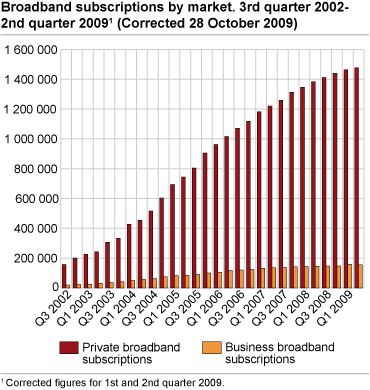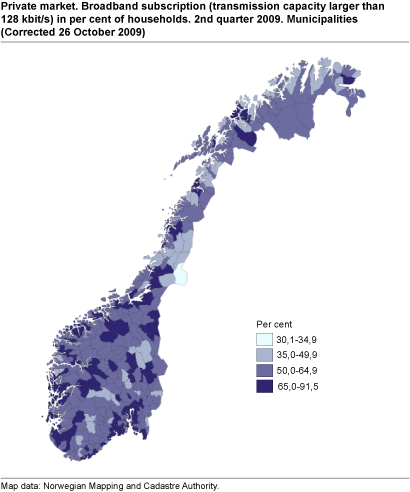Content
Published:
This is an archived release.
Slowdown in broadband growth
The growth rate of number of fixed broadband subscriptions continued to fall in the 2nd quarter of 2009. The average broadband capacity for private subscriptions increased to 5.5 Mbit/s.
|
The publication for the 1st and 2nd quarter of 2009 appeared to be based on serious errors, which had an impact on the conclusions reported. All figures and comments are corrected in this new publication. |
The number of broadband subscriptions with fixed access on the Norwegian mainland was 1 633 000 at the end of the 2nd quarter of 2009; an increase of 7 per cent in the last 12 months. Compared to the previous quarter, there is an increase of 10 000 subscriptions. At the end of the 2nd quarter, Norway had 1 476 000 fixed private broadband subscriptions and 156 000 business subscriptions.
Growth rate of high capacity access slowing down
Private broadband subscriptions with a capacity of more than 8 Mbit/s total 19 per cent; the same as in the previous quarter. Only 6 per cent of business broadband subscriptions have this capacity; the same as in the two previous quarters.
The increase in the number of super high capacity broadband (more than 16 Mbit/s) has pushed up the average capacity to 5.5 from 5.4 Mbit/s. Nevertheless, the median value has fallen slightly, to 3.4 Mbit/s compared to 3.5 in the previous quarter.
Slow growth in fixed broadband subscriptions related to households
The broadband penetration rate in private households increased to 69 per cent from 68 per cent in the last quarter. The figure for private broadband subscriptions per 100 households varies between 76 per cent in the county of Sør-Trøndelag and 56 per cent in the county of Finnmark.
| Centrality1 | Broadband subscriptions | Broadband subscriptions as a percentage of households | |||||||||||||||||||||||||||||||||||||
|---|---|---|---|---|---|---|---|---|---|---|---|---|---|---|---|---|---|---|---|---|---|---|---|---|---|---|---|---|---|---|---|---|---|---|---|---|---|---|---|
| Remote municipalities | 116 814 | 59 | |||||||||||||||||||||||||||||||||||||
| Fairly remote municipalities | 82 174 | 65 | |||||||||||||||||||||||||||||||||||||
| Fairly central municipalities | 239 885 | 66 | |||||||||||||||||||||||||||||||||||||
| Central municipalities | 1 037 176 | 71 | |||||||||||||||||||||||||||||||||||||
| 1 | 1 Centrality 2008, Municipalities 2008. |
The most central municipalities have the highest number of broadband subscriptions relative to the number of households. While the number of broadband subscriptions relative to the number of households is 71 per cent, the corresponding figure for less central municipalities is 59 per cent.
| Municipalities | Broadband subscriptions as a percentage of households | ||||||||||||||||||||||||||||||||||||||
|---|---|---|---|---|---|---|---|---|---|---|---|---|---|---|---|---|---|---|---|---|---|---|---|---|---|---|---|---|---|---|---|---|---|---|---|---|---|---|---|
| Average for all municipalities | 68.9 | ||||||||||||||||||||||||||||||||||||||
| 0941 Bykle | 92.7 | ||||||||||||||||||||||||||||||||||||||
| 0213 Ski | 91.7 | ||||||||||||||||||||||||||||||||||||||
| 0926 Lillesand | 91.7 | ||||||||||||||||||||||||||||||||||||||
| 0215 Frogn | 91.1 | ||||||||||||||||||||||||||||||||||||||
| 1018 Søgne | 88.2 | ||||||||||||||||||||||||||||||||||||||
| 1252 Modalen | 87.2 | ||||||||||||||||||||||||||||||||||||||
| 1151 Utsira | 85.4 | ||||||||||||||||||||||||||||||||||||||
| 1121 Time | 85.3 | ||||||||||||||||||||||||||||||||||||||
| 0521 øyer | 82.8 | ||||||||||||||||||||||||||||||||||||||
| 1601 Trondheim | 82.3 | ||||||||||||||||||||||||||||||||||||||
| 1624 Rissa | 82.3 | ||||||||||||||||||||||||||||||||||||||
| 1046 Sirdal | 82.2 | ||||||||||||||||||||||||||||||||||||||
| 1232 Eidfjord | 82.1 | ||||||||||||||||||||||||||||||||||||||
| 1528 Sykkylven | 82.0 | ||||||||||||||||||||||||||||||||||||||
| 1640 Røros | 81.3 | ||||||||||||||||||||||||||||||||||||||
| 1246 Fjell | 80.2 | ||||||||||||||||||||||||||||||||||||||
| 1563 Sunndal | 80.2 | ||||||||||||||||||||||||||||||||||||||
| 0217 Oppegård | 80.1 | ||||||||||||||||||||||||||||||||||||||
| 1222 Fitjar | 79.9 | ||||||||||||||||||||||||||||||||||||||
| 1264 Austrheim | 79.3 | ||||||||||||||||||||||||||||||||||||||
| 1245 Sund | 79.0 | ||||||||||||||||||||||||||||||||||||||
| 0228 Rælingen | 78.6 | ||||||||||||||||||||||||||||||||||||||
About calculation of median and averageMedian value is the value that divides the population in two equal parts -those with higher and those with lower values. In the calculation of the median value it is postulated that the subscriptions in the capacity band of 2-4 Mbit/s divide themselves evenly on all values in this group. In the calculation of averages it is postulated that the subscriptions divide themselves evenly also in all the other groups. |
|
The mobile broadband access was removed because this part of the statistics has not been complete and because these subscriptions cannot be distributed geographically and by download capacity in the same way as the fixed access subscriptions. The Norwegian Post and Telecommunications Authority also compiles statistics on these mobile subscriptions but without information about the geographical location or download capacity. The number of Internet service providers reporting to this survey has been around 200 over the past two years. Market changes have reduced this number to 187 this quarter. A few small, but locally important Internet service providers, mostly cable TV providers, are still not included in the survey. Efforts have been made to include these providers. Some small errors related to the distribution of subscribers between municipalities may occur. This can have major consequences for the figures per household for some municipalities. The number of households for 2009 has been used in these statistics. Individuals and businesses can have several Internet subscriptions and several individuals can use the same subscription. The number of subscriptions is therefore not equivalent to the number of households/businesses with Internet access. A household can for instance get Internet access through an employer, educational institution or by sharing access with other households. The survey ICT in households provides more information about households with at least one member under the age of 75 with Internet access. For more information, see About the statistics. |
Tables:
- Table 1 Private broadband subscriptions. Subscription by transmission capacity and county including Svalbard. 2nd quarter of 2009 (Corrected 26 October 2009)
- Table 2 Business broadband subscriptions. Subscription by transmission capacity and county including Svalbard. 2nd quarter of 2009 (Corrected 26 October 2009)
- Table 3 Development features. Broadband subscription by market. Active subscriptions only. The whole country without Svalbard (Corrected 26 October 2009)
- Table 4 Broadband subscriptions (larger than 128 kbit/s). Business and private subscriptions. 2nd quarter 2009. Municipality (Corrected 26 October 2009)
Contact
-
Statistics Norway's Information Centre
E-mail: informasjon@ssb.no
tel.: (+47) 21 09 46 42



